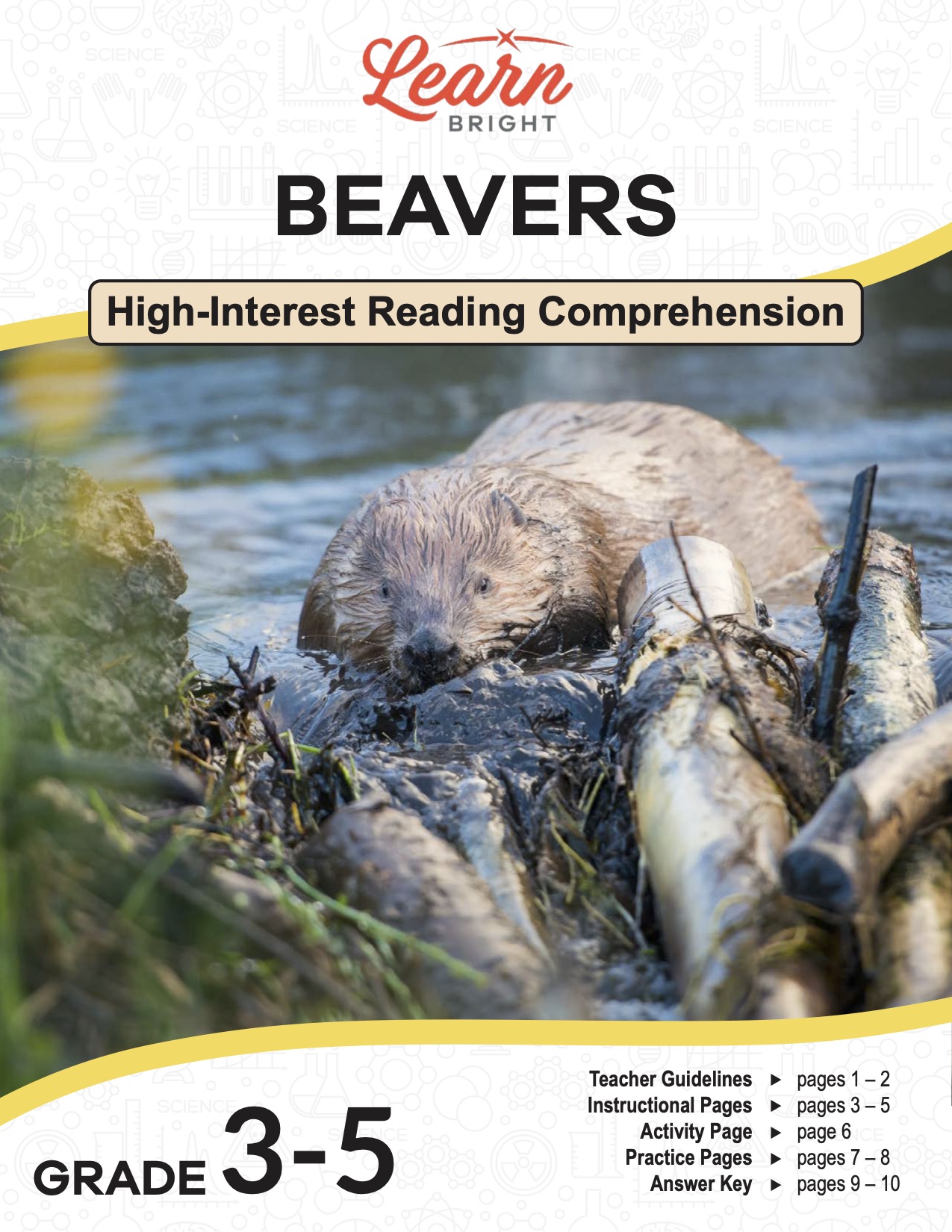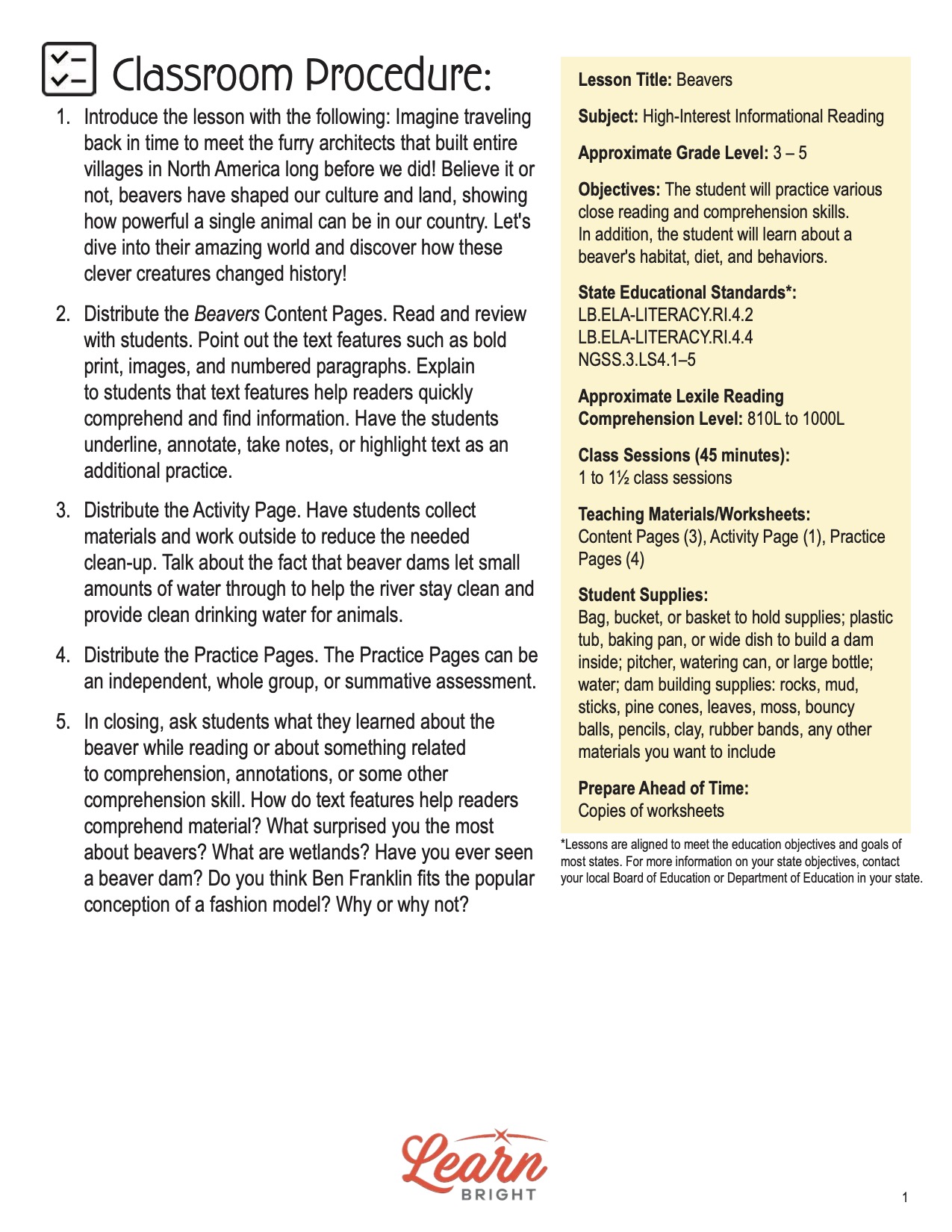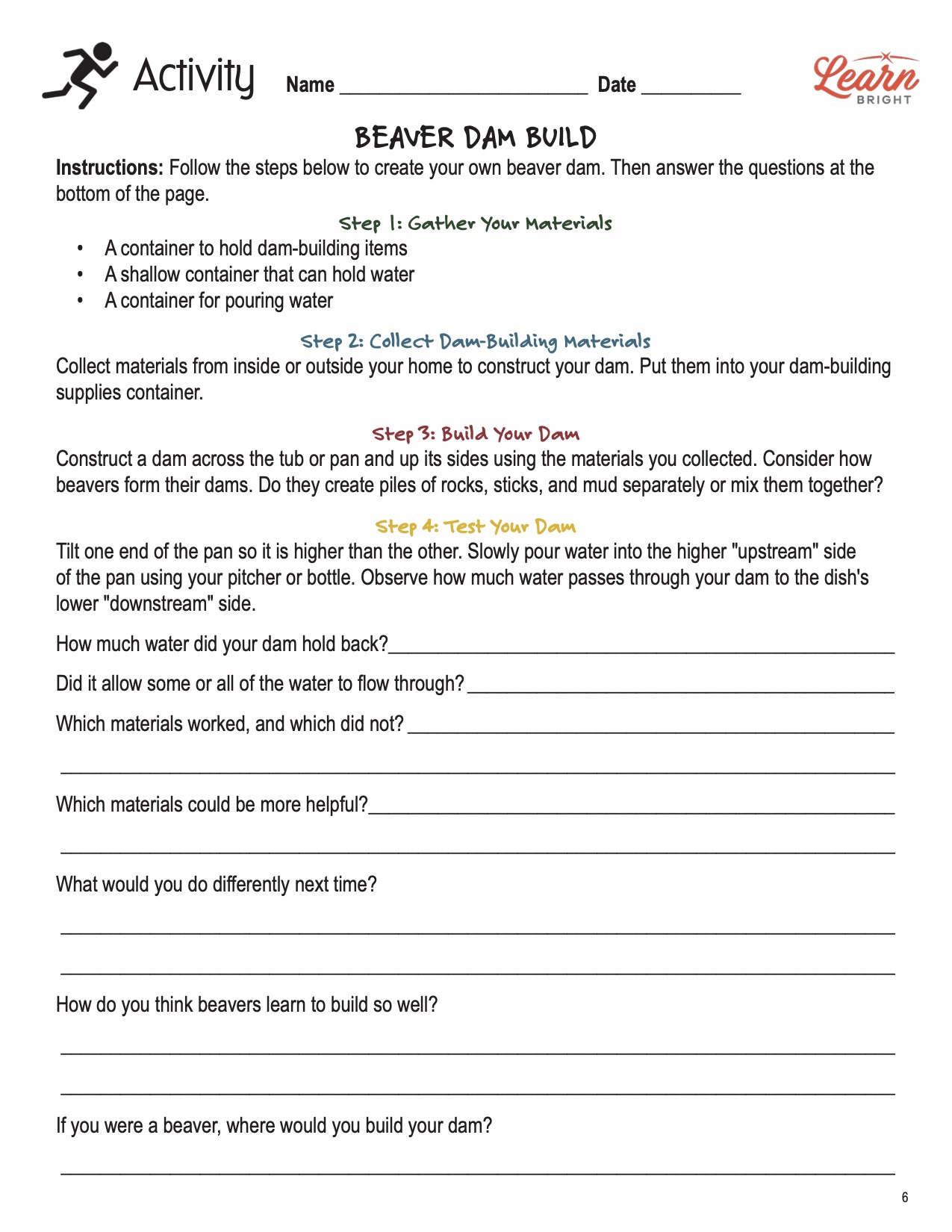Description
What our Beavers lesson plan includes
Lesson Objectives and Overview: Beavers is a high-interest reading comprehension lesson plan. As such, students will practice various close reading and comprehension skills. In addition, they will learn about the beaver’s habitat, diet, and behaviors. This lesson is for students in 3rd grade, 4th grade, and 5th grade.
Classroom Procedure
Every lesson plan provides you with a classroom procedure page that outlines a step-by-step guide to follow. You do not have to follow the guide exactly. The guide helps you organize the lesson and details when to hand out worksheets. It also lists information in the yellow box that you might find useful. You will find the lesson objectives, state standards, and number of class sessions the lesson should take to complete in this area. In addition, it describes the supplies you will need as well as what and how you need to prepare beforehand. You’ll need poster board and markers for the activity in this lesson. There is a list of materials you will need to gather fr the activity portion of the lesson plan, including buckets, water, rocks and other dam building supplies, and baking pans.
Teacher Notes
The teacher notes page provides an extra paragraph of information to help guide the lesson. It explains that you can teach this lesson in a whole-class setting or as an independent, small-group activity. You can use the blank lines to write down any other ideas or thoughts you have about the topic as you prepare.
BEAVERS LESSON PLAN CONTENT PAGES
What Are Beavers?
The Beavers lesson plan contains three content pages. To start off, it provides a small box with basic background information about beavers. These waterproof mammals live in North America, Europe, and Asia. They only eat plants, and they generally live between 10 and 12 years.
Beavers are mammals that live in streams, rivers, and ponds across North America, Europe, and Asia. They have unique features that help them live in water. They are known for their flat tails that look like a canoe paddle. Their fur is waterproof, keeping them warm and dry even in cold water. Beavers also have webbed feet that help them swim fast and dive under water.
They live in groups called colonies. These colonies usually include a family of beavers led by the parents. Beavers build their homes, called lodges, out of sticks and mud. Lodges have underwater entrances to protect the beavers from predators, such as coyotes and bears. Like your house, beavers’ dams have different rooms for eating, sleeping, and raising their babies.
Beavers are very caring parents. They treat their young, called kits, with a lot of love and attention. Baby beavers stay with their parents until they are old enough to find their own home. Beavers teach their young how to swim, find food such as bark and leaves, and build their own lodges when they grow up. This family bond helps the animals stay safe and grow strong in their watery homes.
Diet of a Beaver
Because they eat just plants, beavers are herbivores. Their favorite food is tree bark, especially from trees like aspen, birch, and willow. They also munch on leaves, aquatic plants, and fruits and vegetables. Beavers have strong, sharp teeth called incisors that never stop growing. These teeth are perfect for gnawing through tough bark and branches.
When beavers want to collect food under water, they use their fantastic swimming skills and sharp teeth. They dive down, using their front paws to grab branches and pull them to the surface. Then, they use their teeth to cut the branches into smaller pieces that they can carry back to their lodge or store under water for later. This clever way of gathering food keeps them well-fed throughout the year, even when it’s hard to find fresh plants in winter.
Other Interesting Beaver Facts
Beavers are the nocturnal architects of the animal world. They build dams using sticks, mud, and rocks across streams and rivers. The dams create ponds that provide safe homes for both beavers and other animals. The ponds help regulate water flow and prevent floods downstream. Scientists call these dams “engineered structures” because they change the environment around them by creating habitats for other animals, cleaning the water, and putting more nutrients back into the soil.
One fascinating fact about beavers is that they have the ability to change entire landscapes. The dams they build can create wetlands of natural water gardens full of plants and animals. Wetlands are important habitats for many creatures, including birds, fish, and insects. They also help filter and clean the water that flows through them, making them necessary for keeping ecosystems healthy.
Beavers played a significant role in shaping the United States during its early history. In the 1700s and 1800s, they were hunted extensively for their thick, waterproof fur, which people used to make hats and coats. This fur trade helped drive the exploration and settlement of North America. However, over-hunting nearly caused the poor animal to disappear from many areas. Fortunately, the country enacted laws to protect beavers, and conservation efforts focused on restoring their habitats and populations.
Why They Are Important to the Environment
Because they create unique habitats that support various plants and animals, beavers are incredibly important for the environment. Their dams transform flowing streams into calm ponds and wetlands, providing homes and food for fish, frogs, birds, insects, and other creatures. Wetlands play a crucial role in water filtering and maintaining quality, benefiting wildlife and humans downstream. By altering their surroundings in these ways, beavers boost the biodiversity of the area and support healthy ecosystems.
Currently, beavers are not endangered, but they faced a tough time in history due to over-hunting for their fur. They have made a remarkable comeback thanks to protective measures and conservation efforts. They are now thriving in North America, Europe, and Asia. This success story highlights the importance of preserving wildlife and their habitats. By ensuring beavers have safe places to live and thrive, we can help them maintain healthy ecosystems that benefit countless other species.
Fun Fact!
Benjamin Franklin was a printer, philosopher, publisher, author, inventor, scientist, politician, and diplomat. He was one the most popular leaders of his time and is revered as an American hero. What you may not know is that he was a fashion model, too! When he was in France, he often wore his fur hat to keep his head warm. The hat became very popular in France.
French men and supporters of the American Revolution wore the hat to show their support for America against the British. Later, French women adopted the hat as a fashion item that became all the rage in France in the late 1770s and early 1780s. So, add fashion model to the list of Ben Franklin’s accomplishments!
BEAVERS LESSON PLAN WORKSHEETS
The Beavers lesson plan includes two worksheets: an activity worksheet and a practice worksheet. Each one will help students solidify their grasp of the material they learned throughout the lesson. You can refer to the classroom procedure guidelines to know when to hand out each worksheet.
BEAVER DAM ACTIVITY WORKSHEET
For the activity, students will build their own beaver dams. They will follow the steps on the activity page and use the materials you provide to build their dam. After they finish, students will answer some questions at the bottom of the page.
REVIEW PRACTICE WORKSHEET
The practice worksheet requires students to answer a series of 10 questions. These questions all relate to the content pages, so students will need to refer to them often for the answers. In addition, each question provides which reading tool the question corresponds to, such as text feature, vocabulary, or comprehension.
Worksheet Answer Keys
At the end of the lesson plan document is an answer key for the practice worksheet. The correct answers are all in red to make it easier for you to compare them with students’ responses. If you choose to administer the lesson pages to your students via PDF, you will need to save a new file that omits these pages. Otherwise, you can simply print out the applicable pages and keep these as reference for yourself when grading assignments.









